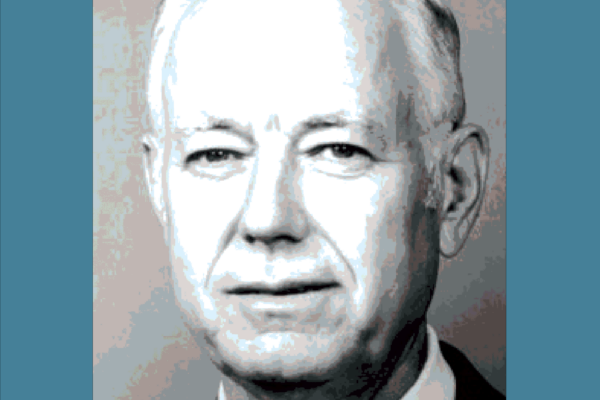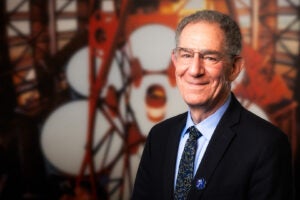One day in mid-April 1996, Virginia Bledsoe’s phone rang. When she answered, there was an FBI agent on the other end of the line. It was a heads-up: be careful about suspicious packages. The name of her husband, Woody Bledsoe, who had died less than a year earlier, had been found in the papers of the recently captured Ted Kaczynski, better known as the Unabomber.
Why? Bledsoe was a leading researcher in the field of artificial intelligence.
The “Un” in Unabomber stood for “university,” and Bledsoe had been a professor at UT, working on artificial intelligence and specifically face recognition, since 1966. (The “a” stood for airline.)
Bledsoe had died in October 1995 at 73 of complications from Lou Gehrig’s disease. Besides being an AI pioneer, he was also a mathematician, Mormon bishop, Boy Scout leader and tennis enthusiast, competing late into his life. A captain in the Army Corps of Engineers, Bledsoe was awarded a Bronze Star for helping find a way for one of Gen. George Patton’s divisions to cross the Rhine during World War 2.
Both Bledsoe and Kaczynski had ties to the University of California, Berkeley, but their time there did not overlap: Bledsoe received his Ph.D. from UC, Berkeley in 1953 and taught there for a few years, while Kaczynski was a doctoral student there from 1967 to 1969, when he abruptly resigned and effectively became a hermit, traveling occasionally but mostly holed up in a tiny cabin in Montana.
In 1960, Bledsoe left UC, Berkeley to work for Sandia National Laboratory in New Mexico, a nuclear weapons research facility. He left Sandia to cofound the AI lab Panoramic Research, Inc. in Palo Alto, Calif., whose anchor clients were the Department of Defense and various U.S. intelligence agencies. Bledsoe described that moment as he addressed the American Association for Artificial Intelligence as its president in 1985:
“Twenty-five years ago I had a dream, a daydream if you will. A dream shared with many of you. I dreamed of a special kind of computer, which had eyes and ears and arms and legs, in addition to its ‘brain.’ When I awoke from this daydream, I found that we didn’t have these things, but we did have some remarkable computers, even then, so I decided then and there to quit my job and set about spending the rest of my life helping bring this dream to reality.”
Bledsoe wrote of his time as president of PRI, “I was spending more and more of my time administering, going to Washington, Albuquerque, or wherever, and less time with the thing I loved, namely science. Also, I had a latent desire to get back to university life, so I accepted an offer as Professor of Mathematics at The University of Texas at Austin.” He joined UT’s math faculty in 1966, eventually chairing the department.
I was spending more and more of my time administering, going to Washington, Albuquerque, or wherever, and less time with the thing I loved, namely science."
In 1981, Japan announced an ambitious “5th-generation” computer initiative to build machines that understood human language and could reason and learn. In response to Japan’s ascendancy in computing generally, in 1983, 20 U.S. technology companies formed a research consortium named Microelectronics Computer Technology Corporation, better known as MCC. The Austin-based consortium hired retired admiral and veteran intelligence officer Bob Inman — still an LBJ School professor today at age 93 — to lead the project, and in early 1984 Bledsoe accepted Inman’s invitation to become MCC’s vice president for artificial intelligence. Bledsoe took a leave of absence from UT, and the next year, 1985, MCC delivered a fifth-generation computer program called Proteus to its shareholder companies.
Inman, a UT Distinguished Alumnus, told the Austin American-Statesman in April 1996, “I’m not surprised that Woody Bledsoe would make it on to the [Unabomber’s] list, because of his fame in the country in the area of artificial intelligence, trying to make computers think … to act as if they think, and that’s the thing that would have caught the attention of this guy who was antagonistic toward technological developments.”
He returned to UT is 1987 as the Peter O’Donnell Jr. Centennial Chair in Computing Science. Bledsoe retired reluctantly in 1994, the year before his death, when he determined ALS had affected his speech too much to allow him to teach effectively.
In 2023, Kaczynski died in a federal prison in North Carolina, aged 81.
Some 39 boxes containing Bledsoe’s papers, most relating to early face-recognition research, are housed in UT’s Briscoe Center for American History. “Those boxes contain, among other things, dozens of photographs of people’s faces, some of them marked up with strange mathematical notations — as if their human subjects were afflicted with some kind of geometrical skin disease,” wrote Shaun Raviv in a 2020 feature on Bledsoe in Wired magazine.
In an exhaustive memorial tribute in AI Magazine in 1996, colleagues Michael Ballantyne, Robert Boyer and Larry Hines wrote of Bledsoe: “He was perhaps the most wonderful person we have ever known. He was the sort of perfect embodiment of faith, hope, and charity. It’s almost as though he was not subject to the common human frailties. We never saw him discouraged, we never saw him depressed, and we never saw him unkind.”




